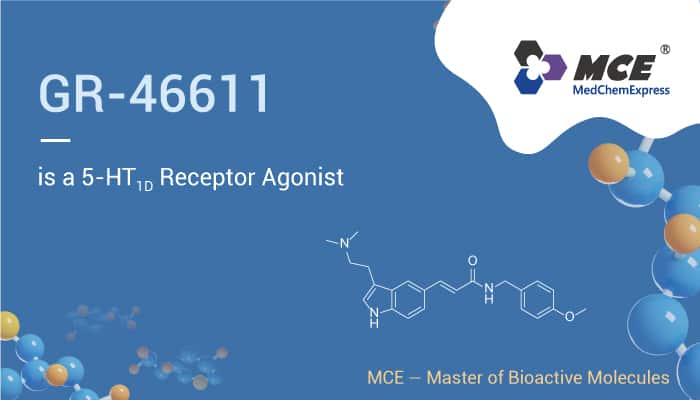5-HT1D (5-hydroxytryptamine (serotonin) receptor 1D) is a G protein-linked receptor that activates an intracellular messenger cascade to produce an inhibitory response by decreasing cellular levels of cAMP. Besides, 5-HT1D acts on the central nervous system and affects locomotion and anxiety. Importantly, it also induces vasoconstriction in the brain. Particularly, 5-HT1D is abundant in the dorsal horn of the spinal cord and shows low levels in the basal ganglia (globus pallidus, substantia nigra, caudate putamen), the hippocampus, and the cortex. Moreover, Studies show that 5-HT1D agonists have potent antiseizure effects. Here, we will introduce a small-molecule agonist of 5-HT1D.
GR-46611 is a potent and selectively 5-HT1D receptor agonist.

First, GR-46611 protects dravet syndrome mice from seizure and early death. Second, GR-46611 (1 µM; 48 h) induces human T lymphoblastic leukemia cell proliferation by 37.0%. Idiographic, GR-46611 significantly increases the threshold of hyperthermia-induced seizure and lowers seizure severity. In addition, GR-46611 (1 mg/kg; i.p.; daily for 32 days) significantly improves survival with 89% surviving at p32 in Dravet syndrome (DS) mice. In brief, GR46611 given chronically reduces mortality in DS mice and may represent a meaningful target for pharmacotherapy for DS with potential relevance for related forms of epilepsy.
GR-46611 inhibits bladder activity under nociceptive. Specifically, GR-4661 (0.01, 0.1, 1, 10, 100 µg/kg; i.v.) significantly increases in threshold volume, bladder capacity, and residual volume in a dose-dependent manner in spinal cord injury (SCI) cats. Moreover, The results show that the effects of 8-OHDPAT but not GR-4661 (3, 10 µg/kg; i.v.) are largely reversed by WAY-100635 (5-HT1A antagonist).
In a world, GR-46611 is a potent 5-HT1D receptor agonist. Besides, GR-46611 induces cell proliferation and has the potential for the research of epilepsy, and inhibits bladder activity under nociceptive.
Reference:
[1] Hatini PG, et al. Eur J Neurosci. 2020 Nov;52(10):4370-4374.
[2] Gu B, et al. J Pharmacol Exp Ther. 2004 Sep;310(3):1266-72.